Assassin’s Creed: Revelations – Review
by Stu
|
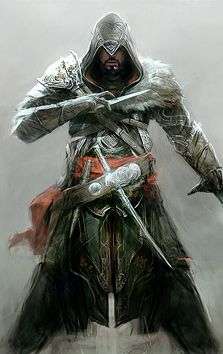 Assassin’s Creed: Revelations is the fourth major release for the franchise in five years, no mean feat from Ubisoft and arguably quite a risk to try and keep a ‘triple A’ series on a yearly release schedule as they have managed to do since Assassin’s Creed 2. Being the fourth game in a well-known series also means that there will be some comparison and linking to its predecessors, so consider this your spoiler warning if you are not yet up to speed with the story from previous games.
Assassin’s Creed: Revelations is the fourth major release for the franchise in five years, no mean feat from Ubisoft and arguably quite a risk to try and keep a ‘triple A’ series on a yearly release schedule as they have managed to do since Assassin’s Creed 2. Being the fourth game in a well-known series also means that there will be some comparison and linking to its predecessors, so consider this your spoiler warning if you are not yet up to speed with the story from previous games.
Once more you are mainly playing the part of Ezio, the introductory video giving a welcome synopsis of the events to date, and you’ll also be taking on the roles of Altair and Desmond in the process. After the events of Assassin’s Creed: Brotherhood, Desmond was comatose and placed into the animus to keep him alive and this is where the game starts – literally. With a scene reminiscent in style to the training program in The Matrix you find yourself on a beautiful island with floating rocks, a partial henge-like structure and an eager to chat Subject 16. Both Desmond and Subject 16 are in a testing program of sorts, the most basic of Animus programs, and just as Morpheus explained all to Neo, Subject 16 does the same to Desmond. I’ll leave you to discover the details when you play it; I can already feel people shouting “Spoiler!!” at the screen.
After the little chat and walkabout with Subject 16 I decided to go exploring the henge-like area in the middle of the island, it’s very pretty and quite zen in a way. Great monoliths of stone pierce the island area and its an instant reminder of how detailed and awe-inspiring the Assassin’s Creed worlds are. For my troubles I was treated to a conversation that seemed to be happening in the real world between several returning characters you’ll recognise from previous games. This happens a few times when returning to the island or after playing memories and it keeps the player appraised of happenings outside the animus.
Taking the next logical step I wandered into the blue nexus type thing that will take me to the first of the memories and encountered another video scene; I began to think that so far I’d been in the game a good twenty minutes and hadn’t managed to stab anyone through the neck. Having said that, Assassin’s Creed is always about more than going stab-happy in a crowd, sure they are fun moments, but in order to truly enjoy any Assassin’s Creed you have to engage with the bigger story. Revelations does a fantastic job of not just bringing you up to speed but also laying out the over-arching story and the sub-plots beneath it.
Leaving Desmond behind, I stepped into Ezio’s furry assassin boots once more and the oft-familiar tutorial level kicked in. Immediately the two worlds of Altair and Ezio clash for I was standing in Masyaf and it was exactly how I remembered, at least the layout was, and this place has long since been lost to the Assassins. I followed the Eagle-vision ghost of Altair as he leapt up walls and across ledges, causing a tiny wave of goose-pimples to shoot over me as I reminisced briefly about my first foray into the Assassin’s Creed world and how different it was from anything else I’d ever played before. I then considered how far the game has come since 2007, both technically and lore-wise. Standing atop the spires in Assassin’s Creed was the first ever game to instill the true feeling of being up high and, as I hate heights, looking down did make me feel literally dizzy sometimes. In fact I’d go as far as to say it’s the only game that makes my ballsack retract with that weird tingly feeling when I think I’ve missed a hand-hold and am about to plummet to my death. Sometimes the intimacy you feel with the game is just amazing.
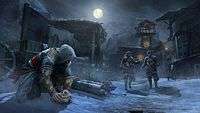 |
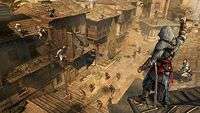 |
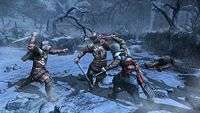 |
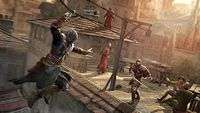 |
 |
 |
If you weren’t already aware, Ezio is old in this memory set, or old for those days at least. Personally, I prefer him in Revelations to the previous games, I outright hated him in Assassin’s Creed 2, but that’s all in the past and as we’ve watched him age he’s now, rightfully, a master assassin and I actually care for the character’s story when in the beginning I was only playing to find out more about the Desmond arc and desperately wanting more Altair. Ubisoft play on the age too, with passers by commenting as you scale buildings and your new assassin buddy, Yusuf, often making Ezio seem out of touch when introducing two of the new features to the game: bombs and the hook blade. This time around you can’t help but feel a little sorry for Ezio who is still searching for answers and running out of a lifetime to do it in, even his charming words to the ladies only gets a nice smile in response – clearly he is not the much-swooned Casanova of his youth. That said, his aged skin, greying beard and shabby armour do not stop him being every inch the master assassin – limber and lithe as if he was still twenty years old.
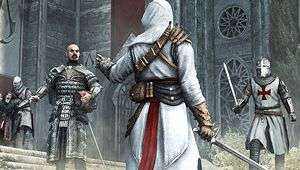 Altair also makes a very welcome comeback and you’ll get to experience a fleshed-out storyline for him covering events both pre and post the first Assassin’s Creed. Although more like side-missions, the Altair parts are integral to the story and finally the mountain of questions that has been building up get answered… well, some at least. Whilst I was a little disappointed at the amount of Altair content I could see how adding more would strain or break the flow of the Ezio storyline and, after giving the game some retrospective, I think Ubisoft made the right balance choices.
Altair also makes a very welcome comeback and you’ll get to experience a fleshed-out storyline for him covering events both pre and post the first Assassin’s Creed. Although more like side-missions, the Altair parts are integral to the story and finally the mountain of questions that has been building up get answered… well, some at least. Whilst I was a little disappointed at the amount of Altair content I could see how adding more would strain or break the flow of the Ezio storyline and, after giving the game some retrospective, I think Ubisoft made the right balance choices.
Although Assassin’s Creed: Revelations is ultimately a vehicle to continue Desmond’s story, that part deliberately fades into the background to make way for the conclusion of Altair and Ezio’s story lines. While I wouldn’t rule out them making another appearance in some fashion, I find it highly unlikely that they will be explored as fully-fledged memories by the player. Suffice to say, Ubisoft has done very well in wrapping up the sub-plots, weaving them into the over-arching story and passing the focus back to Desmond, ready for the next installment.
Once inside Ezio’s memories you are fully entering the open-world section of Revelations. The majority of the game is set in Constantinople, giving a really nice mix of architectures, reminding you of Assassin’s Creed with the domed spires of mosques, foreboding fortress walls and then adding in the columned ruins, gardens and housing similar to that in Ezio’s homeland from the Renaissance era games. The game fuses and mixes more than just the memories in the storyline; the whole environment is geared towards blurring the lines between the games just like the mixed up and fragmented mind of Desmond. It’s a subtle effect but works well to add to the feeling of coming full circle.
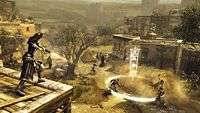 |
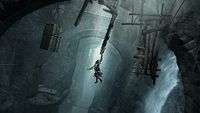 |
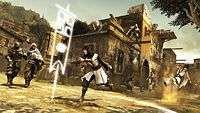 |
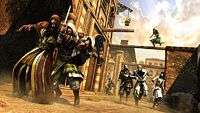 |
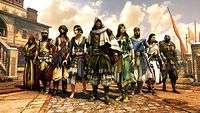 |
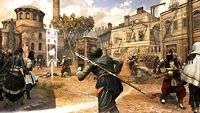 |
I opted to immediately start seeking out the viewpoints as I like a fog-free map, rather than follow the exclamation mark to the next part of the story. I was surprised (and happy) that I could access everything but one area practically from the start, allowing me to choose how I wanted to proceed through the game. Climbing is as it was in previous games: mostly painless, easy and intuitive with paths up buildings being more obvious than at times in previous incarnations. The hookblade (more on this later) makes scaling vertical gaps between architecture a breeze but there are sometimes still issues with climbing where the character gets ‘stuck’ and refuses to move to the next climb point. This first happened when following Altair on the training mission, climbing up to a point below a crenellation he then went left and skirted around, whereas my Ezio just sat and refused to acknowledge the option. As in prior Assassin’s Creed games, retreating a little and re-attempting that part of the climb enabled it to work successfully but, later on, when climbing and being pelted by stones, arrows or gunfire it isn’t brilliant to have that glitch occur. There is also the issue with jumping off of masonry by accident instead or jumping up or sideways to grasp the next ledge, although as I’ve had this issue with every Assassin’s game it could just be me being too hasty with my climbing.
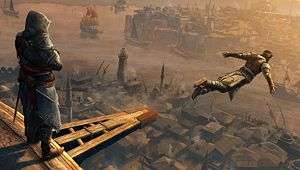 After making it to the top of the tower and perching myself on the pigeon’s ledge I instinctively pressed Y. Not much happened. I’m not quite sure why, but for some reason on the fourth game into the series Ubisoft decided to switch Eagle Vision and syncing to a press of the left analogue stick. You are prompted, when reaching the ledge, to sync and so you are soon educated into the new controls, but it just seemed an odd thing to do. In addition, the clicking to enter Eagle Vision required me to be stationary, if I was clicking whilst the analogue stick was also directional then the game wouldn’t register it.
After making it to the top of the tower and perching myself on the pigeon’s ledge I instinctively pressed Y. Not much happened. I’m not quite sure why, but for some reason on the fourth game into the series Ubisoft decided to switch Eagle Vision and syncing to a press of the left analogue stick. You are prompted, when reaching the ledge, to sync and so you are soon educated into the new controls, but it just seemed an odd thing to do. In addition, the clicking to enter Eagle Vision required me to be stationary, if I was clicking whilst the analogue stick was also directional then the game wouldn’t register it.
Eagle Vision itself has had something of a modification. As in Brotherhood it can pick up trails, except now it will show any guard patrol routes as well as any trails appropriate to missions. In addition it is used to analyze people or objects to pick out potential threats, or locate items a certain person have interacted with. While it is a great feature, I did wonder if at times it was getting a little too ‘Batman’ for my liking, but any damage taken during combat will knock you right out of Eagle Vision and obviously you have none of the other heads up information in that mode, so it isn’t as though you’ll be playing the whole game with it on.
Drawing upon the previous Ezio outings, you are able to renovate the city by purchasing shops and historical attractions. As before, you are able to draw money from any banks that you have purchased and money is deposited every 20 minutes. Likewise the stores you renovate provide you wares as well as income with the colour customisation of Ezio’s outfit making a return for those assassins that prefer a bit of colourful flair in their attire.
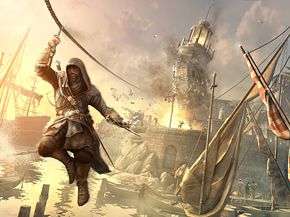 All of the features from Brotherhood and previous Assassin’s games have been included: crowd-melding, pick-pocketing, aerial assassinations, hirelings, throwing money, etc. In addition there is now the hook-blade which adds two new features. The first is the ability to use zip-wires which also allows you access to a new assassination technique as well as a cool way to get between buildings, the second is as a combat weapon. Using the hookblade you can trip fleeing foes or use it to escape yourself by pulling the enemy down and rolling over their back. I found the hook-roll a little tricky to perform and mostly ignored that capability during combat – I’ll just keep stabbing them through the neck, thanks… if it ain’t broken…
All of the features from Brotherhood and previous Assassin’s games have been included: crowd-melding, pick-pocketing, aerial assassinations, hirelings, throwing money, etc. In addition there is now the hook-blade which adds two new features. The first is the ability to use zip-wires which also allows you access to a new assassination technique as well as a cool way to get between buildings, the second is as a combat weapon. Using the hookblade you can trip fleeing foes or use it to escape yourself by pulling the enemy down and rolling over their back. I found the hook-roll a little tricky to perform and mostly ignored that capability during combat – I’ll just keep stabbing them through the neck, thanks… if it ain’t broken…
Bombs are a new weapon in Ezio’s arsenal. There were lots of rumblings about having 300 bomb types, but in reality you’ll use about four or five tops and most of those 300 variants are big, medium or small effect coupled with sticky, on impact or timed detonations. The game makes quite a big deal about them, littering the map with black-market bomb salesmen and crafting benches. You also can’t loot anything without a selection of bomb components getting reeled off. Thankfully once you find a set of bombs you like crafting you can sell the other components and boost your cash income. I may have painted the bombs in a bad light; they are incredibly useful, particularly against enemies in pillar-box styled enclosures that you can’t get at with melee weapons, but they do seem rammed down your throat somewhat.
Aside from the new weapons, combat has been left pretty much alone since Brotherhood but I think that’s a good thing as it has reached the edge of the comfort zone for me with the D-pad weapon switching, the left trigger to initiate targeting and then the right trigger for walking/attack and free-running/defence. That’s already a fair amount of stuff to think about in order to just stab someone in the face. The only negative aspect of all the upgrades since the original game is that combat has become a trivial matter. Call in assassins, use bombs or get to a zip-line and you are done – there isn’t the pressing element of danger that used to exist when getting into a scrap with guards. It used to be a tactical decision about when and where to engage, but now you can run through and kill a large number of guards with an arrow strike as if they were nothing. I would have welcomed Ezio having a bit of challenge added back into his combat with some evolved enemies to combat these over-powered abilities.
 |
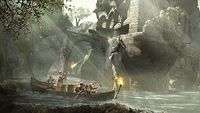 |
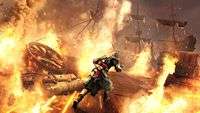 |
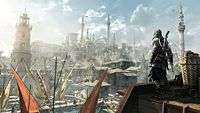 |
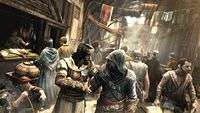 |
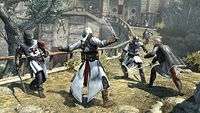 |
As previously, if you do somehow manage to get yourself into bother you can break combat and run for it. Once again there are no major overhauls here, the whole idea behind Revelations was to progress the story, not revolutionise the Assassin’s Creed gameplay. All the usual hiding places appear once more: rooftop gazebos, wells, haycarts and giant piles of leaves resembling pink pot pourri (more than any city should generate!) – in addition there are tents and even large flowered bushes to hide in.
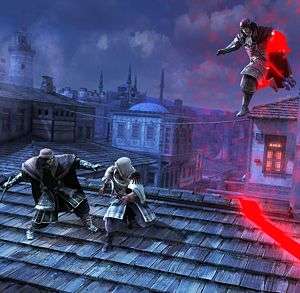 So from combat to collectibles, or lack thereof… there are no flags. I’ll say it again in case you think you misread. There are no flags! There are no feathers either. In fact, collectibles have been shaved right down to under 140. Oh come now, you didn’t think they’d remove them totally did you? This time you have a hundred Animus fragments to collect, 10 manuscript pages and a few books.
So from combat to collectibles, or lack thereof… there are no flags. I’ll say it again in case you think you misread. There are no flags! There are no feathers either. In fact, collectibles have been shaved right down to under 140. Oh come now, you didn’t think they’d remove them totally did you? This time you have a hundred Animus fragments to collect, 10 manuscript pages and a few books.
Treasure chests are back too, but there doesn’t seem to be any achievements or anything special unlocked for collecting them all. They contain more bomb components than money and if you buy the maps only a few show up at a time – I suspect only the ones with money or components you are not yet filled to the brim with in your inventory. As before, collectibles appear in Eagle Vision and you can get maps, although some must be unlocked (collecting 50 fragments grants you the fragments map to pick up the rest, for example).
Other components from previous games are here too. The hireling groups each have a headquarters from which you can get quests and complete the challenge lists to unlock new features and equipment. The tax collector makes a return although I saw one far less often than previously, but the chase and takedown are still rewarded well by coin. There are also a number of stalkers who will leap out and try to attack you throughout the game, they are easily dispatched with but their timing can sometimes put a mission in jeopardy – a clever addition. Assassin recruits are back and, as before, you send them out into the world to do missions in order to level up, as well providing backup in tough fights, calling them in with a swift whistle.
In addition to the missions, the recruits can try to reclaim a city for the assassins and once done can also be remotely placed in cities to gain xp, allowing you build up quite a number of operatives. Ultimately though I never saw the point in it as whilst in those cities the recruits didn’t seem to be available as backup (obviously) nor take part in missions… even those ones in the same city as they were based. Having said that, the more operatives assigned to a city, the greater the maximum degree of control you have over the city, so you can build up a large amount of control and then neglect it for a while without fear of a Templar counter-attack. It’s hardly Risk or Civilisation but it can be fun to play about with. It acts as a good cash earner and also, once a city is owned, a cash vacuum.
Training assassin recruits to the master rank has a second purpose: assigning them to a den. Similarly to Brotherhood where you’d take the Borgia towers, in Revelations you do the same but then move in to set up shop yourselves. If your reputation gets too hot then the Templars will counter attack one of your dens and instigate a den defence mini-game. If you install a master assassin then he deals with any threats and you’ll never have to worry about an attack on that base again.
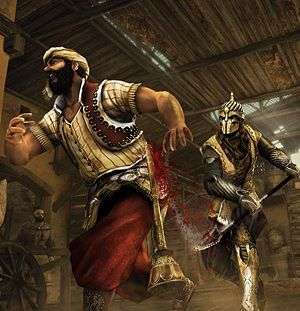 As far as the new mini game goes, basically it’s kind of a poor man’s tower defence. You get to look down the alley leading up to your den from a rooftop and place men and barricades along it in order to stave off the Templar forces that come flying through. Each rooftop must have a leader assigned in order to place additional defensive units and you buy leaders (and all units) using morale. You gain morale by killing Templars, sometimes also from looting fallen enemies and you can also recall units for a refund of morale so pitiful it is pointless to do so.
As far as the new mini game goes, basically it’s kind of a poor man’s tower defence. You get to look down the alley leading up to your den from a rooftop and place men and barricades along it in order to stave off the Templar forces that come flying through. Each rooftop must have a leader assigned in order to place additional defensive units and you buy leaders (and all units) using morale. You gain morale by killing Templars, sometimes also from looting fallen enemies and you can also recall units for a refund of morale so pitiful it is pointless to do so.
The defensive units come in a range of styles from ranged rifleman to brawlers, and barricades come from wooden walls to flame turrets. The Templars have a similar array of units at their disposal too. As the player you can join in by using Ezio’s wrist-pistol and by calling in cannon strikes but most of the time you’ll be busy trying to replace fallen units and looting enemies for precious morale points.
Overall the den defence is a bit rubbish and easily the weakest part of this game – it should have been cut in my opinion. The camera angle is often too constrictive with no zoom in or out to see where units may be failing. There is not much in the way of health indicators other than on barricades and the Templar siege units, so you can’t plan replacements properly. It’s a real shame as it could have been something special, but ultimately the experience is shallow and after my second base defence I’d already had enough and was training master assassins to stop me having to go through it again. Sadly I did go through it, twice more… with one instance hanging the system on the last man of the final wave.
The final new feature surrounds Desmond. You don’t play Desmond as you have done previously or as you play Ezio and Altair in Revelations. You get to play him from a first-person perspective, and instead of those weird mind-boggling puzzles of pictures, symbols and numbers requiring explicit knowledge of the Fibonacci sequence and so forth, this time around it’s spacial platform puzzling. Not too unlike FPS Tetris combined with Monty Mole. Sounds weird, right? Wait until you play it. I actually enjoyed those Desmond sections, they ultimately serve as narrative pieces and aren’t usually more than five to ten minutes long but I can see how it might drive a few people crazy or not really be up their street.
 Graphically the game is vibrant and alive. As with all games like this, you do get a lot of repetition of character models and similarly with some buildings too, which can sometimes be enough to jar you out of the world and back to reality. The clouds in the sky and the general day and night cycle are impressive, particularly when watching the cityscape below from atop a high tower. The video cut-scenes are CGI and the increase in fidelity is noticeable compared to scripted game engine scenes. That may sound as though the graphics are lacking in some way and, for the most part, that is not the case – it looks great, although sometimes things like people’s hands had reflective, glossy qualities. Unless you are sitting next to a top of the line PC playing it too then the graphics are more than acceptable considering the age of the console hardware.
Graphically the game is vibrant and alive. As with all games like this, you do get a lot of repetition of character models and similarly with some buildings too, which can sometimes be enough to jar you out of the world and back to reality. The clouds in the sky and the general day and night cycle are impressive, particularly when watching the cityscape below from atop a high tower. The video cut-scenes are CGI and the increase in fidelity is noticeable compared to scripted game engine scenes. That may sound as though the graphics are lacking in some way and, for the most part, that is not the case – it looks great, although sometimes things like people’s hands had reflective, glossy qualities. Unless you are sitting next to a top of the line PC playing it too then the graphics are more than acceptable considering the age of the console hardware.
If there was one bad comment on the graphical presentation then it would be the Animus ‘glitch’ effect, where bits of the screen get messed up like when satellite TV loses its reception a little. I guess it was to try and emphasise the broken state of Desmond’s mind, but I found it too much. The world disintegrating and going to a blueprint-like state is great, I get that, but having parts of the screen leaping about when you do anything from load the game to buy a shop is just irritating. I was constantly fighting the urge to knock the TV on the side like old people do when their TV doesn’t pick up the signal.
The audio is a subtle balance between ambient city noise, the noises you need to hear (guards, important conversations, etc) and the background music. The music is understated with plenty of female vocals ‘ahhing’ (in a non-sexual way) and accompanied by guitar, wind instruments or slightly more regional sounding instruments, the names of which I would not know. Naturally this all changes when in combat and the sleepy, ambient dronal sounds erupt into a fast-tempo affair with a bit of drum for good measure. In keeping with previous games, the musical score will not surprise or disappoint.
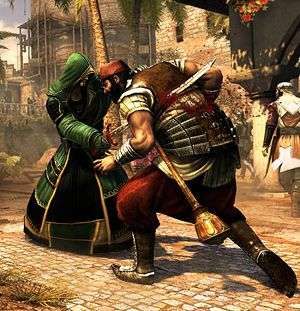 The vocal acting is good with the accents not being too ridiculously stereotyped, although a few more lines for generic crowd people would be nice – there are only so many times I can bear to hear lines like “why behave like a rabid monkey?”. I haven’t checked but the voice actors for recurring characters, including those from the first game, seem to have been brought back. If not, then good likenesses have been brought to bear and everyone sounds as you’d remember.
The vocal acting is good with the accents not being too ridiculously stereotyped, although a few more lines for generic crowd people would be nice – there are only so many times I can bear to hear lines like “why behave like a rabid monkey?”. I haven’t checked but the voice actors for recurring characters, including those from the first game, seem to have been brought back. If not, then good likenesses have been brought to bear and everyone sounds as you’d remember.
Assassin’s Creed: Revelations has done a good ‘refine and enhance’ exercise on the previous game – den game aside – so what’s missing this time around, other than flags? The tomb exploring is still there, although technically not tombs per se. It’s been shrunk down significantly in terms of length and injected with scripted moments to keep the pace fresh. I welcomed that change myself as the previous explorer sections were far too dull and full of lever-pulling.
Horses have been put out to pasture with the flags, which is understandable considering the single location and the fact that you can use the sewers to quick-travel. I’m not sorry to see the horses go; there is a mini-game type sequence involving a horse and carriage which were low-points, but the free-riding horses are completely removed. Leonardo’s flying machine is another travel method that doesn’t make a reappearance. That said, parachutes are still about and a very useful feature when you can’t find a handy haycart parked beneath your spire. The final removal is the Animus Training Program. I did a little dance of joy when I realised that hasn’t made a re-appearance. The challenges were appealing to some, but I found them of no purpose or enjoyment; I’m not sad to see the back of those leaderboard wielding, medal based kill-joys.
Basically, everything you’ve come to expect from an Assassin’s Creed game is there, and around it you have the well written database detailing everything in the game world, the DNA sequences allowing you to replay and fully sync memories, challenges, etc. Additionally the tutorials have all been cleverly bundled into loading screens and on first-time events, so you can just press ‘select’ on the tool-tip loading screen to go to that tutorial, and once completed it dumps you right back where you left off – something I really thought was quite good.
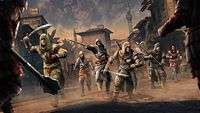 |
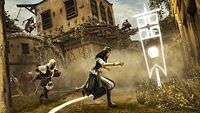 |
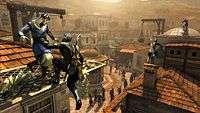 |
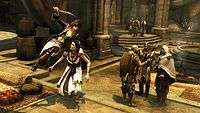 |
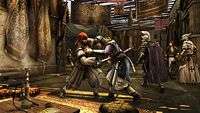 |
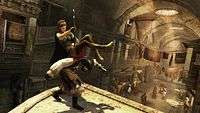 |
So, with the Animus challenges gone how are you going to brag about your ‘mad assassin skills’? Well, that’d be multiplayer then, which is, of course, back for a second round and does not detract from the quality or quantity of the single-player game. This was my first experience with multiplayer, having skipped it in Brotherhood as I had no interest in it, but after several hours and many, many stabbings through the head I finally had the gist of it. To be fair the multiplayer introduction is one of the best I’ve ever encountered. Set up as an Abstergo employee training program you get a nice corporate video at the beginning and are then taken through a tutorial of the basics before a basic public deathmatch. Upon completion of that, the more advanced features are explained and you are placed into another public game.
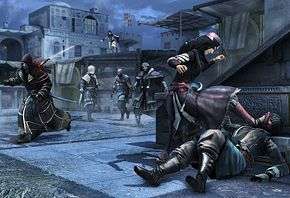 At time of writing there are 10 modes, split into three areas: Deathmatch, Free For All and Team. They are all pretty standard multiplayer fare with most modes being some flavour of ‘kill them before they kill you’ with capture the flag and protect an asset thrown in for good measure. One thing I couldn’t get my head around on a number of games is that when someone is hunting you, you can’t turn around and stab them; if you confront a pursuer you’ll always be killed (but lessen their kill bonus). Even after a whole morning of multiplayer I still hadn’t got the ‘flee’ mentality right. That is if I saw the pursuer before having half a sword thrust into my eye socket…
At time of writing there are 10 modes, split into three areas: Deathmatch, Free For All and Team. They are all pretty standard multiplayer fare with most modes being some flavour of ‘kill them before they kill you’ with capture the flag and protect an asset thrown in for good measure. One thing I couldn’t get my head around on a number of games is that when someone is hunting you, you can’t turn around and stab them; if you confront a pursuer you’ll always be killed (but lessen their kill bonus). Even after a whole morning of multiplayer I still hadn’t got the ‘flee’ mentality right. That is if I saw the pursuer before having half a sword thrust into my eye socket…
The multiplayer is fun and engaging, particularly the team modes, although some aspects are already struggling to find players. Twice the host disconnected an artifact assault game and a couple of the modes I had to come back to later as the matchmaking couldn’t find anyone else interested in that mode at the time. When that occurs it’ll dump you into a similar styled game (i.e team based for artifact assault) or a deathmatch game. The matchmaking system is fairly swift compared to some and should make Gears of War 3’s system hang its head in shame. I never had to wait more than 20 seconds before it was loading the next game from selecting my match type of choice. Considering that a large proportion of the audience is likely to buy this for the single player experience, the speed and smoothness put into the match making is commendable.
In fact the entire system is incredibly well done, from the intro to the levelling up and perks system. You can completely customise your character or ‘persona’ as Abstergo refers to it. Useful abilities and perks are unlocked by levelling, others such as vanity titles are unlocked by performing tasks, challenges and gaining accolades (such as ‘The Immortal’ title for not dying in a round) – some are even unlocked from performing single player tasks.
In addition there is a constant reminder of friends’ scores and the leaderboard system is easily accessible should you wish to climb the ladder to glory. There isn’t any kind of challenge/brag system in place so you’d have to rely on a friend wanting to beat your score or telling them yourself you’ve overtaken them, old school. There are also some basic statistics but you’ll mostly spend your time in a game or tinkering with your perk/ability load-outs.
The multiplayer itself plays like the single player, except for a much dumbed down control system, especially combat. You often find yourself melding into crowds, cowering in a haystack or free-running for your life. You use B to try and stun pursuers and X to kill targets, with special features used by the bumper buttons such as throwing knives or stun bomb (each of which has a significant cooldown). My personal favourite was the Wanted mode, but mainly because I think that was the only one I managed to come first in once. As multiplayer modes in games go, this is well implemented, suits the game well and is very easy to pick up and play, whatever your skill level.
Pros- Excellent narrative and evocative events throughout
- Improved additions to the weapons arsenal
- Immersive game world with graphics and soundtracks to pull you in
- It answers a whole lot of questions
- Is everything you’d expect from a major Assassin’s Creed release
- Den defence game is a massive let down
- The ‘animus glitch’ effect needs to be toned back at times
- The crowd vocals could do with a few more phrases as a completionist will hear them all... a lot
- The ability to call assassins, bombs and zip-lines make combat and evading a little too easy; once you’d fear getting into a fight you couldn’t handle but that threat is now pretty much removed altogether
I couldn’t have asked for anything more than what this game provides in terms of Assassin’s Creed. Nostalgia from the recurring characters, new features and combat options, slightly updated graphics, a compelling set of storylines and something that finally doesn’t leave me with more questions than I had at the beginning! There are so many small touches that suck you into the universe, from the dramatic skylines to the letters Ezio writes for Claudia, from vertigo-inducing climbing to reading reams of information in the database. This game is made with passion and that feeling is almost palpable as you play. The team behind it made the absolute best of the yearly time frame they were given and the result is a game that stands head and shoulders above some games that have been in development far longer. Having spent three games as Ezio it is sad to think that he will no longer be uttering ‘bene’ and I’ll no longer be immersed in the amazing renaissance world Ubisoft had created. Progression is a necessity though and as Ezio and Altair's swan song, this game cannot be accused of doing anything but sending them out on a high note.
I know a lot of people found the original dull and samey, particularly collecting the 600 flags, but despite that it had been my favourite of the series. I say ‘had’ because it’s just been usurped by its youngest sibling. By no shadow of a doubt, Assassin’s Creed: Revelations is the strongest of the series to date. With plenty of pace and enough side activities to keep explorers happy, this game should appeal to any who’ve enjoyed a previous Assassin’s title. In fact, anyone who needs to play catchup could just jump back in with this game thanks to the introduction sequence and converging stories.
Last five articles by Stu
- When A Choice Isn't Really A Choice At All
- Best of 2013: Next-Gen: #Fail
- Deadfall Adventures - Review
- Assassin's Creed IV: Black Flag - Review
- The Inner World - Review















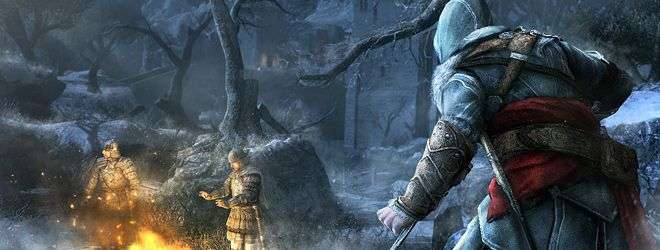
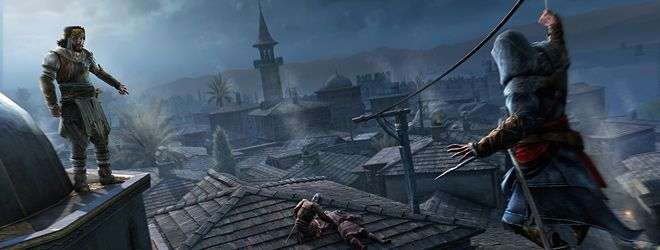
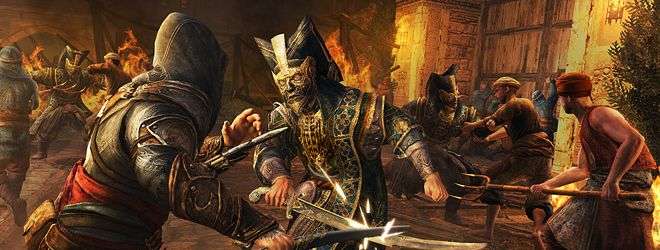
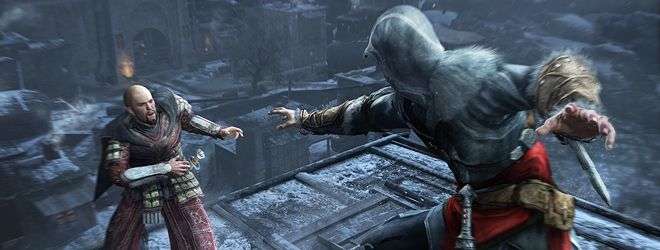
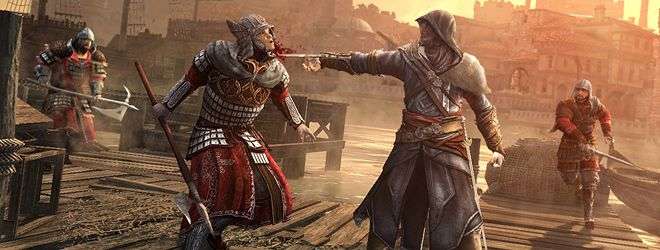






Goddamn it, I still haven’t played Brotherhood. Owned it for ages now.
Ah well.
AssCreedRevs does intrigue though.
Good job, Stu. Unfuckwittable write up.
[...] which went against every geeky fibre in my body. After the Assassin’s Creed assignment (viewable here – a great addition to the series) I started my trip into Skyrim. I shouldn’t have [...]
Excellent review Stu.
I have to say that I wasn’t going to touch this at all having read other reviews and user comments and getting slightly tired of the Ezio storyline but this has changed my mind. I’ll definitely be looking to pick this up as a loan/rental rather than a full purchase.
From my point of view I’m surprised they’ve done three games featuring Ezio, making the series feel more like AC1, 2, 2.5 and now 2.75 with only incremental upgrades and tweaks to the graphics, gameplay etc rather than sweeping changes. This is even more telling with AC3 already pencilled in for next year – can they really keep banging these games out year after year without watering down the brand entirely?
Having played a few hours of the multiplayer in AC: Brotherhood, if I did pick this up I doubt I’ll touch this aspect at all. It was OK when running round with 2 or 3 friends but with randoms I felt no compulsion to play. This was primarily down to the fact that, as you mention in the review, having clearly spotted your pursuer the only option you have is to run away rather than duelling it out – master assassin my a*se.
Good review, good sir!
Not an Assassin’s Creed person meself, but I still found this really informative and awesome to read
I’ll be playing this at the weekend. I love the AC series even though I think that they perhaps need to move on from Ezio’s story now. Hopefully we’ll get something fresh and new in AC 3. Good work Stupot